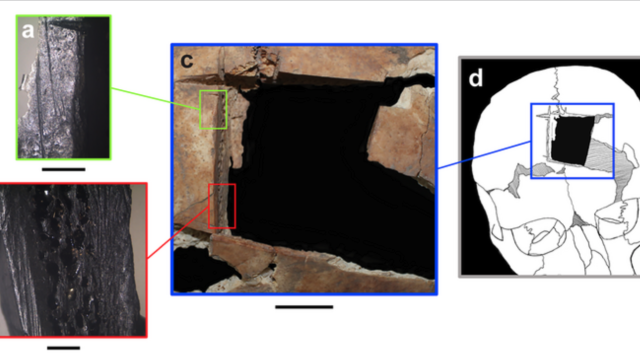For 3,500 years, a curious medical case has been buried beneath the floor of a Bronze Age building in Israel. Now, a team of archaeologists has studied the remains of two wealthy brothers entombed there, finding that both likely struggled with chronic infectious disease in childhood. The two skeletons showed signs of porosity, lesions, and inflammation that suggest some long-term disease like tuberculosis or leprosy. Most interestingly, one of the skulls had been cut open while the young man was still alive, in a case of trepanation.
The rudimentary brain surgery may have been an attempt to treat his ailing body, but he died during or shortly after the surgery. The team’s research describing on the skeletons is published today in PLoS One.

“We have evidence that trephination has been this universal, widespread type of surgery for thousands of years,” said Rachel Kalisher, an archaeologist at Brown University and the study’s lead author, in a university release. “But in the Near East, we don’t see it so often — there are only about a dozen examples of trephination in this entire region.”
The brothers were buried at Megiddo, an ancient settlement that would have straddled the Via Maris, a route that connected important regions like Egypt and Mesopotamia. Based on the quality of the goods buried with the two males and the evident medical care they received, the researchers believe the brothers may have been well-to-do or elite members of the Megiddo community.
Trepanation, also spelled trephination, is done to relieve pressure buildup in the skull. In this case, one of the brothers (estimated to be about 1.52 m 6 inches and 21 to 46 years old when he died) had an approximately square-inch piece of his skull cut out. While it may have helped with pressure, it clearly didn’t benefit him much: Based on the team’s analysis, the man died within days of the operation, if not during it.
Judging by the ways the remains of the brothers were deposited, the team suspects that the second individual (the younger brother, if only by a few years) died a year or two before his sibling.
Importantly, the two brothers apparently weren’t rejected or alienated despite their serious ailments, the team noted in the paper. “In antiquity, there was a lot more tolerance and a lot more care than people might think,” Kalisher said in the release. “We have evidence literally from the time of Neanderthals that people have provided care for one another, even in challenging circumstances.”
“I’m not trying to say it was all kumbaya — there were sex- and class-based divisions,” Kalisher added. “But in the past, people were still people.”
More: Why in the World Did Ancient Humans Perform Brain Surgery On This Cow?
Editor’s Note: Release dates within this article are based in the U.S., but will be updated with local Australian dates as soon as we know more.
